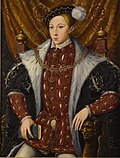| Years |
|---|
| Millennium |
| 2nd millennium |
| Centuries |
| Decades |
| Years |
July 1553: England ruled by Edward VI, Jane and Mary I
| 1553 by topic |
|---|
| Arts and science |
| Leaders |
| Birth and death categories |
| Births – Deaths |
| Establishments and disestablishments categories |
| Establishments – Disestablishments |
| Works category |

Year 1553 ( MDLIII ) was a common year starting on Sunday of the Julian calendar.






